
A visit to the “Big Smoke” wouldn’t be complete without seeing some of the famous London landmarks. These destinations are what make London the world-class city and tourist attraction that it is!
These iconic landmarks of London range from centuries-old buildings and monuments steeped in history to sparkling modern skyscrapers. The city’s eclectic variety of architecture adds to its charm and helps to make it one of the most popular cities in the world.
Whether you’re a first-time visitor or a local, there is something enthralling about visiting the London icons. Even as a born and bred Londoner, I never tire of seeing them.
In this guide, I will take you on a photographic journey to all of the best and most iconic London landmarks while providing detailed information on each. You will find interactive maps, galleries, history, tours, and everything else you may need to know
🏛 55 Most Famous London Landmarks: An Overview

The 55 most famous landmarks in London are:
- Big Ben
- Houses of Parliament
- Tower Bridge
- Tower of London
- St Paul’s Cathedral
- Buckingham Palace
- Westminster Abbey
- London Eye
- Trafalgar Square
- Piccadilly Circus
- British Museum
- Natural History Museum
- Science Museum
- Victoria and Albert Museum
- Imperial War Museum
- National Maritime Museum
- London Transport Museum
- The Churchill War Rooms
- Royal Observatory
- National Gallery
- Tate Modern
- Somerset House
- Royal Albert Hall
- Shakespeare’s Globe
- Wembley Stadium
- The O2
- Madame Tussauds
- The Shard
- The Gherkin (30 St Mary Axe)
- Sky Garden and the Walkie-Talkie Building
- One Canada Square, Canary Wharf
- City Hall
- Millennium Bridge
- Chinatown Gate
- Royal Parks
- Kew Gardens
- Hampstead Heath
- Holland Park
- Regent’s Canal
- Kensington Palace
- Hampton Court Palace
- Battersea Power Station
- Covent Garden
- Monument to the Great Fire of London
- Downing Street
- HMS Belfast
- Cutty Sark
- Borough Market
- Camden Market
- Portobello Road Market
- River Thames
- Red Phone Boxes
- Red Double Decker Buses
- Black Cabs
- The Tube
Each of these iconic London landmarks are discussed in greater detail throughout the remainder of this guide.
🗺 Map of Famous Landmarks in London
If you’re planning on adding stops at some of the city’s most famous landmarks to your London itinerary, then this map will help you plan!
I’ve pinned and colour-coded all the London landmarks within this blog post pinned on the map below, with the exception of the “Quirky London Landmarks.”
Click the image below or here to access an interactive Google Map.

🏴 Top 10 Famous London Landmarks
At no cost to you, we receive a small amount for any bookings made using the links below.
First up are my top 10 famous London landmarks. These are the destinations that personify London; the ones that no trip would be complete without!
If you’re a first-time visitor to London then make sure you don’t leave the Big Smoke without at least ticking these top 10 off your London bucket list.
Before we get started, you will notice that I mention the London Pass and Go City Pass a lot in this blog post. These city passes include entrance to many of London’s top attractions.
Additionally, they will often provide “skip the line” access, as well as discounts at many other places.
I have written all about them in our London itinerary if you’d like to know more. I have even included how to calculate its trip-by-trip value to see if it’s worth getting one for your visit!
All prices are correct as of December 2023.
🕐 1. Big Ben

Big Ben is perhaps the most recognisable clock in the world and the most famous London landmark.
When you think of London, undoubtedly you will conjure up an image of this famous clock tower perched alongside the Houses of Parliament as it majestically overlooks the River Thames.
With construction completed in 1859, the famous four-faced clock has been accurately keeping time for over 150 years.
Today, its iconic architecture is firmly etched in most people’s vision of London. If there is one true must-see on every London bucket list, Big Ben is it.
⭐️ Pro Tip: It is a beautiful sight to behold any time of day. However, I recommend trying to see it at night as it is a little extra magical with the clock face lit up!

Having been fully renovated and re-opened in 2023, it is now possible to take a tour of Big Ben. Tickets cost £25 and can be booked on the Parliament website.
Unfortunately, the tour is not suitable for everyone, as you must be able to climb all 334 steps unaided without assistance. Due to the structure of the tower, accessible step-free tours are not available.
⭐️ Pro Tip: If you’re a UK resident, it is possible to take a free tour. To do so, you must request a tour from a Member of Parliament or the House of Lords.
🏢 2. Houses of Parliament

Alongside Big Ben, the Houses of Parliament is perhaps the most famous landmark in London. Formally known as the Palace of Westminster, it is the meeting place of the British government.
Following a great fire in 1834, nearly all of the original Palace of Westminster was destroyed. The present-day building was constructed in a Gothic architectural style between 1840 and 1870 and continues to sit proudly on the bank of the River Thames.
Tucked away within these walls, the Great Hall is all that remains of the medieval Old Palace.
The Palace of Westminster, along with Westminster Abbey and Saint Margaret’s Church, are a UNESCO World Heritage site. Many important historical events have occurred within these three famous buildings over the centuries.
While most are content to marvel at its glorious architecture from outside, visiting the Houses of Parliament at certain times is possible. Within it, you can discover plaques commemorating many famous figures and the impressive architecture of the Great Hall.
Check the official Houses of Parliament website for more information. Alternatively, you can book a guided tour or an audio tour of the Houses of Parliament.
🌉 3. Tower Bridge
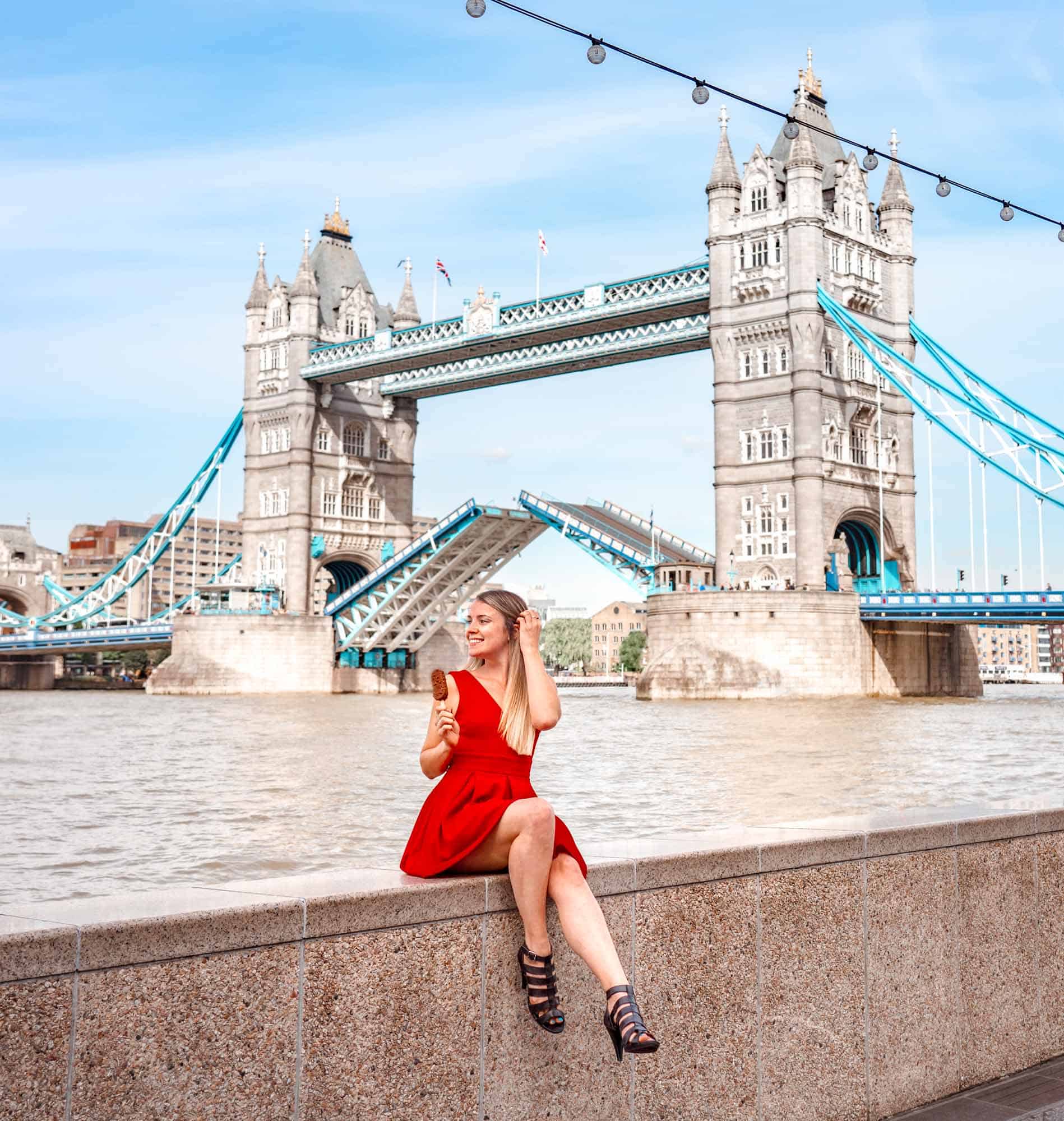
As one of London’s defining landmarks, Tower Bridge is one of my favourite places to visit in London.
Despite being the most famous bridge in England, if not the world, it is often mistakenly referred to as London Bridge (which is, in fact, the next bridge along to the west and rather uninteresting).
Constructed between 1886 and 1894, it has become a prominent feature of the city. Today, the bridge is still essential for crossing over the Thames, with over 40,000 people crossing Tower Bridge every day.
What many people don’t know is that the bridge regularly lifts to allow ships to pass! Bridge openings typically happen every day and it’s an impressive sight.
You can find the lift times listed on the Tower Bridge website.
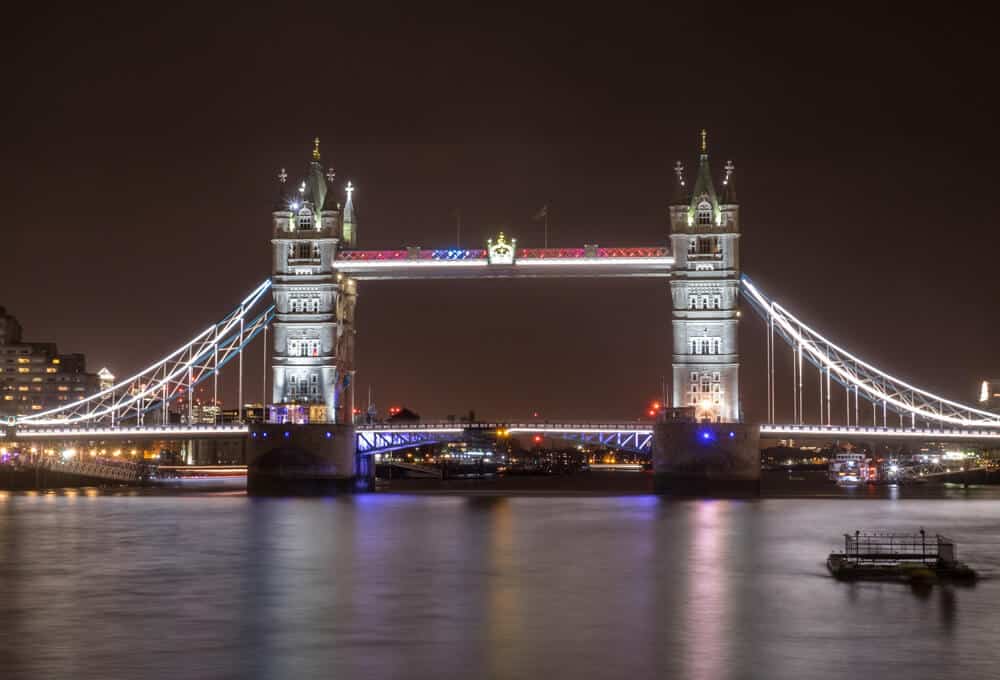
For those interested in photography, this impressive landmark provides numerous photo opportunities for some great shots of London. There is even a hidden little sandy beach by the river near Tower Bridge for the perfect Insta-worthy shot.
Check out my post on the best places for photos in London for details on how to find it and more photo inspiration!
If you want to learn more about the extensive history of Tower Bridge, or take in some stunning panoramic views, then you should consider a visit to the “Tower Bridge Experience.”
Entrance costs £12.30 when booked online but is also covered by the London Pass and Go City Pass. Included in this experience is a walk along the high-level walkway and, if you’re brave enough, over the glass walkway suspended above the bridge.
🏰 4. Tower of London

Dating back to the 11th century, the Tower of London is another of London’s UNESCO World Heritage Sites. Despite there being some beautiful castles near London, the Tower of London is the only castle actually within central London.

Having stood for over 1000 years, this historical monument has served many different purposes from a fortress to a prison, a royal mint, and even a zoo!
Since the 1600s, the Tower has also been home to the royal family’s most precious possessions – the coronation regalia known as the Crown Jewels. They are carefully watched over by the Yeoman Warders, or Beefeaters, considered England’s most powerful soldiers.

Today, the Queen’s Crown Jewels are still kept here and guarded by the Beefeaters. However, the Tower is now also one of London’s most popular tourist attractions and the Beefeaters also serve as tour guides.
In fact, it is the most popular paid attraction in all of England!
If you’d like to see the Crown Jewels and learn more about the history of the Tower of London, tickets cost £33.60 when booked online in advance. Entry is also included in the London Pass and Go City Pass.
Alternatively, you can visit by booking a group tour with skip-the-line tickets.
🏰 YOU MAY ALSO ENJOY:
BEST CASTLES NEAR LONDON
⛪️ 5. St Paul’s Cathedral

St Paul’s Cathedral is an architectural masterpiece and one of London’s most iconic buildings. This magnificent cathedral has been a significant part of the London skyline for over 300 years and was the tallest building in London from the time of its completion in 1710 until 1967.
To this day it remains such an important London landmark that views of it are protected from many areas. These views include King Henry VIII’s Mount in Richmond Park, Primrose Hill, and Parliament Hill.

A walk around the perimeter of this spectacular church will allow you to marvel at its grandeur and impressive exterior. However, it is also well worth visiting inside to explore the depths of St Paul’s.
Once inside this massive building, you can ascend the 528 steps to reach the top of the Dome and take in panoramic views of London.
You can also explore the crypt, where you’ll discover the resting places of several notable people including Christopher Wren, Admiral Nelson, and The Duke of Wellington.
If you have a London Pass or Go City Pass, entrance to St Paul’s is included. Otherwise, you can buy fast track passes online, which are cheaper at £20.50 than buying them on the day.
⭐️ Pro Tip: Head to the rooftop of One New Change for one of the best views, and my personal favourite view, of St Paul’s Cathedral.
🤴🏻 6. Buckingham Palace

A list of the top 10 landmarks in London would be incomplete without including the Queen’s King’s official residence; Buckingham Palace.
The stunning architecture is as regal and opulent as you may expect with its sheer grandeur, carved intricacies, gold-decorated gates, and elaborately uniformed guards.
However, this was not always the case! The building was originally known as Buckingham House and almost became the British Museum back in the 17th century.
Throughout the 19th and 20th centuries, it was extended and today the royal residence has 775 rooms and the largest private garden in London.
During the summer, you can take tours of some of the lavish staterooms within the palace. Tickets cost £32 when booked online. Alternatively, consider a walking tour with a palace visit.
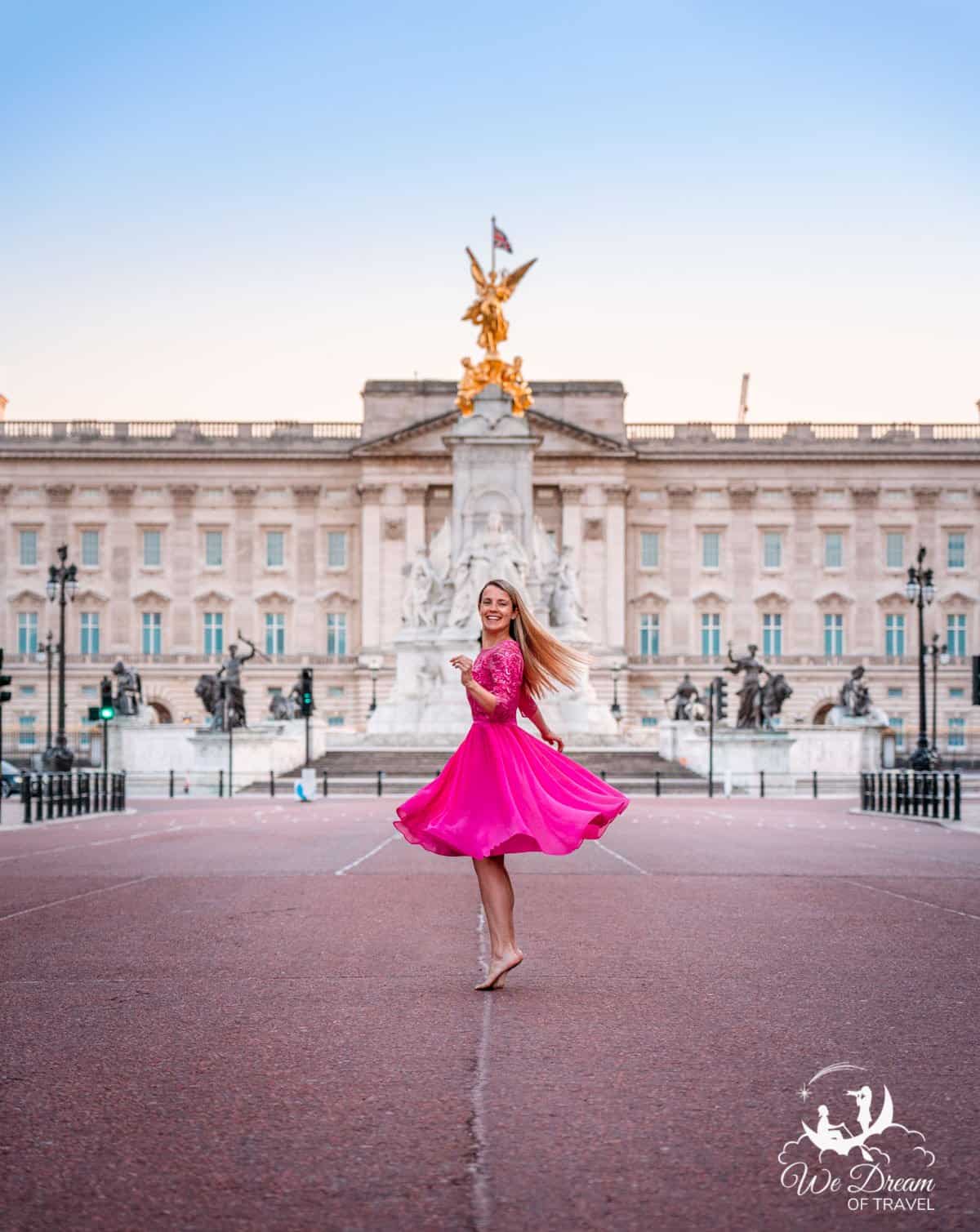
My favourite view of Buckingham Palace is from The Mall. This famous London street leads directly up to the palace and is coloured red to imitate a giant red carpet!
It also gives you a great view of the Victoria Memorial, a monument to Queen Victoria.
💂♀️ Changing of the Guard

Witnessing the changing of the guard ceremony is one for the London bucket list for first-timers to the city. It’s also considered one of the best things to do in London with kids.
As it only occurs on certain days, make sure you check the times and best spots to observe the ceremony on the Changing Guard website.
You can also book a Changing of the Guard tour which will give you more information on the history of the ceremony, as well as take you to the best places to observe it. Some of these tours also include entry to Buckingham Palace.
Due to its popularity, be prepared for huge crowds and to be stuck there for some time.
I have to be honest, I personally think it’s overrated, horribly crowded, and a bit of a waste of time. However, I appreciate that my opinion isn’t a popular one and others love it so still wanted to include it in case it’s something you might enjoy!
If you just want to see a horse and guard, then there are always (at least every time I’ve passed!) two stationed at the front of Horseguards.
💒 7. Westminster Abbey

Dating back to 960 AD, this royal church and UNESCO site is a truly iconic building. It has been the place of many important events over its 1000 years of history.
Since 1066, Westminster Abbey has been England’s coronation church, as well as the burial site for many previous monarchs.
Westminster Abbey has also hosted 16 royal weddings, the most recent nuptials being those of the Duke and Duchess of Cambridge in 2011.
With its Gothic architecture, Westminster Abbey is perhaps even more beautiful inside. Those that are visiting for worship can do so for free.
However, tourists wishing to visit all the tombs, monuments, or the Abbey Museum will need to buy an entry ticket. Entrance to this famous building costs £29.
If you decide to buy a London Pass or Go City Pass, Westminster Abbey is one of the attractions included. You will also find many different tour options that include entry to Westminster Abbey.
If you’re in London at Christmas (which is a beautiful time to be in the city!), visit the Abbey for a Christmas service.
🎡 8. London Eye

The most recently added London landmark is the London Eye, which was constructed in 1999 and opened on Dec 31, 1999, to mark the turn of the millennium.
At the time of its construction, the London Eye was the tallest Ferris wheel in the world at 443ft (135m). It held this title until 2006 when it was surpassed by the Star of Nanchang in China.
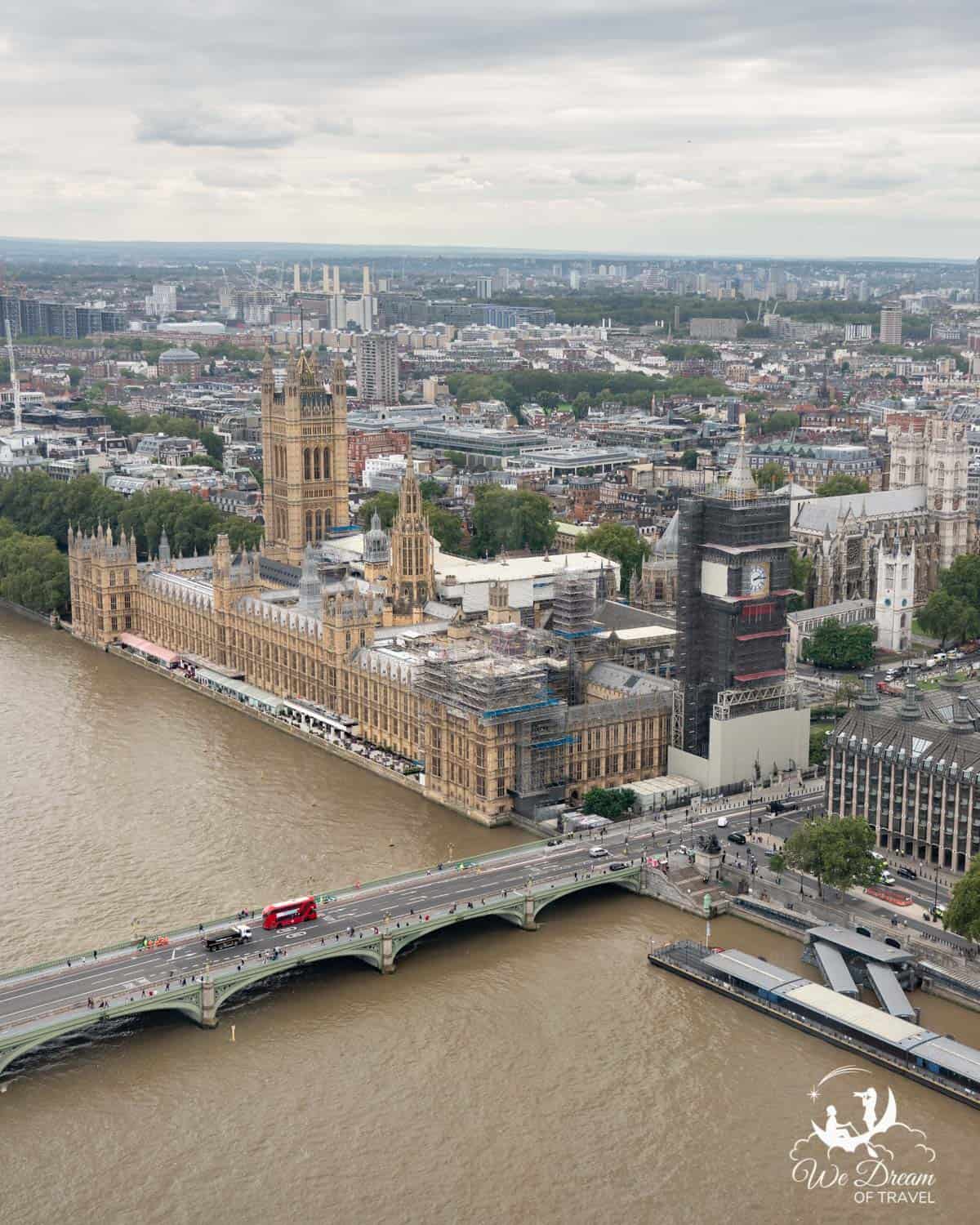
While riding the London Eye is one of the top things to do in London for many, I honestly find it very underwhelming and think it’s a waste of money!
I’ve been on it three times now, most recently in the summer of 2022, and I just can’t get excited about it!
There are just too many better viewpoints in London. I recommend investing your money in a cocktail with a view instead.
However, the London Eye itself has become an iconic feature of the London skyline and ranks as one of the best London photo spots.
While I don’t personally recommend riding the Ferris wheel, make sure you do take in a visit to at least get that requisite vacation photo or Insta-worthy shot!
For those of you who do want to ride the London Eye, tickets start at £29.50 off-peak when booked online. You’ll also find various combo tickets, including the London Eye and other attractions.
📸 YOU MAY ALSO ENJOY:
MOST INSTAGRAMMABLE PLACES IN LONDON
⛲️ 9. Trafalgar Square

Trafalgar Square has been a significant London landmark since the 1200s when it was used as the courtyard for the King’s Mews (horse stables) during the reign of King Edward I.
It wasn’t until the early 1800s that development took place, slowly transforming Trafalgar Square into the public square we see today.
Officially given its name in 1830, it serves as a monument to commemorate the Battle of Trafalgar fought in 1805.

Nelson’s Column was added in 1843, paying tribute to the admiral who lost his life during this battle. Then later in 1867, the four famous bronze lions were created. All of these have also become London icons in their own right!
Today, Trafalgar Square is surrounded by some of London’s top attractions, including the National Gallery. It also holds many public, family-friendly events throughout the year, ranging from Chinese New Year to Pride in London.
🚥 10. Piccadilly Circus & Leicester Square

Piccadilly Circus and Leicester Square are like the London equivalent of Times Square… but smaller and with more charm!
Lying in the heart of Theatreland, they are a hugely popular tourist attraction, filled with theatres, cinemas, bars and restaurants.
The Shaftesbury Memorial Fountain (more commonly, and incorrectly, referred to as the “Statue of Eros”) also serves as a common meeting place.
While I’d recommend that you avoid eating here (it’s a tourist trap that only offers overpriced, crappy food), Piccadilly Circus is a great place to soak up the buzz of the city for anyone who doesn’t mind a crowd!
I’m probably in the minority of Londoners when it comes to my feelings about Piccadilly Circus and Leicester Square, but I just LOVE them. There’s something about the electric atmosphere here that conjures up excitement.
💂♀️ Famous London Landmarks: Museums, Galleries and Entertainment Venues
London is home to some of the world’s best museums, galleries, theatres, sports grounds, and music venues. Some of my fondest childhood memories are visiting the London museums.
As well as being famous for their collections or shows, these places are renowned London landmarks for their architecture and are also part of the building blocks of the city.
🗿 11. British Museum

Image © The Trustees of the British Museum.
The British Museum is not only the oldest museum in England but also the world’s oldest public museum. Founded in 1753 and opening its doors to the public in 1759, it has enamoured visitors for over 250 years.
Today, it is consistently one of England’s most visited attractions.
It is home to around 8 million artefacts, including mummies and the Rosetta Stone. In addition to its impressive collection, it is worth visiting the British Museum just to admire its phenomenal architecture, particularly that of the Great Court.
Perhaps the best thing about visiting the British Museum is that, like most of the museums in London, general entry is free of charge.
🦖 12. Natural History Museum

Located in South Kensington, you will find a trio of London’s greatest museums all within a few minutes walk of each other.
The first of these is the Natural History Museum, which is by far my favourite museum in London! Having grown up with a fascination with the natural world, I’ve always loved wandering the dozens of exhibitions while exploring 4.5 billion years of our Earth’s history.
It seems I’m not alone, as in 2022 it was the most visited museum in London, beating the British Museum, which has historically held this accolade.
Founded in 1754, the Natural History Museum holds a wealth of treasures and is now home to 80 million specimens. However, only a small percentage of these are on display at any given time.

While the collections are incredible, it is worth visiting just to admire the building itself. Both the interior and exterior are decorated with elaborately moulded terracotta tiles.
When inside, look closely at the walls as you’ll find, sculptures of living and extinct fauna and flora adorning the tiles and bricks.
🔬 13. Science Museum
Founded in 1857, the Science Museum is now the most-visited science and technology museum in Europe.
It is an excellent museum for kids, with over 15,000 objects on display highlighting the importance of science and its achievements over the years.
In addition to numerous interactive exhibits, you can also experience the thrill of flying a Red Arrows jet in a 3D simulator or watch a film at the IMAX cinema.
👗 14. Victoria and Albert Museum
The Victoria and Albert Museum, also commonly referred to as the V&A, is the world’s leading museum of art, design and performance.
Housing a collection of over 3.5 million objects, you can discover over 5,000 years of human design and creativity.
💂🏼♀️ YOU MAY ALSO ENJOY:
THE PERFECT LONDON ITINERARY
15. Imperial War Museum
The Imperial War Museum was founded in 1917 while the First World War was still raging with the intent to record the civil and military war effort.
Today, it is the world’s leading museum of war and conflict and one of London’s iconic landmarks. The exhibitions here give great insight into the extraordinary experiences of ordinary people forced to live their lives in a world torn apart by conflict.
My first visit to the Imperial War Museum was as a kid as part of a school field trip and it quickly became one of my favourite museums in London. It is one of the most inspiring and moving museums.
⚓️ 16. National Maritime Museum
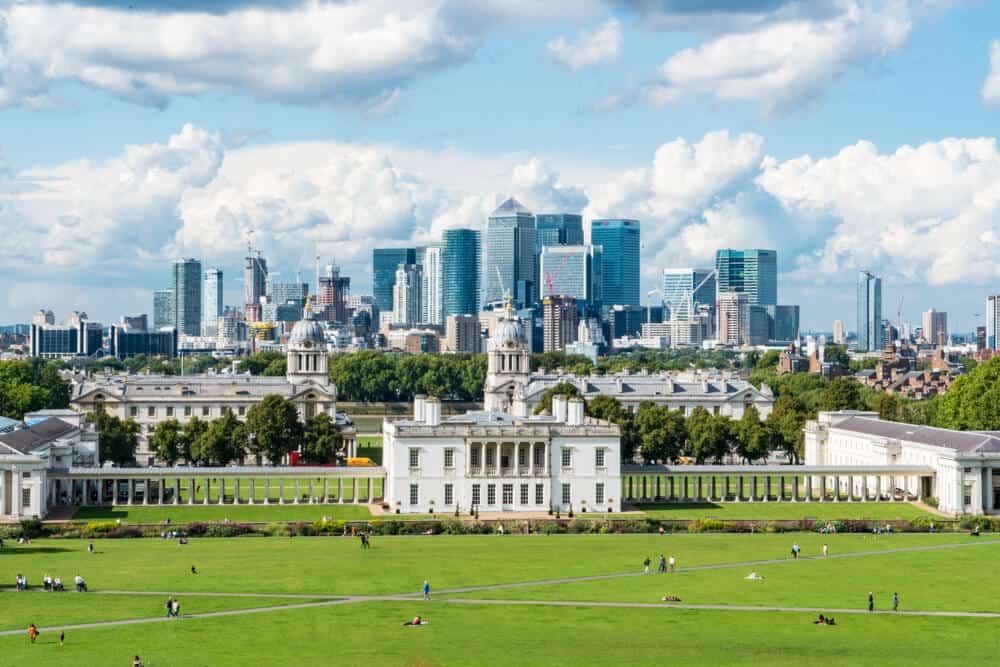
Part of the Royal Museums Greenwich, the National Maritime Museum is the largest museum of its kind in the world and is free to visit.
Here you’ll discover a trove of maritime treasures and incredible tales of adventure. Some highlights include a real Fijian canoe, Yinka Shonibare’s Ship in a Bottle, and over 230 figureheads from ships.
🚂 17. London Transport Museum
Named ‘Visitor Attraction of the Year’ at the 2022 London Tourism Awards, the London Transport Museum is one of the most famous places to visit in London.
Opened in 1920, the London Transport Museum showcases over 200 years of London’s iconic transport system and how it impacted the growth of the city, its culture, and society.
Its collection features over 500,000 items, from locomotives that powered the world’s first underground railway, to one of the most important collections of 20th-century poster art.
This is a particularly fun museum to visit with kids as it has lots of interactive, hands-on exhibitions.
💣 18. The Churchill War Rooms
During World War 2, the Churchill War Rooms were secret basement offices that served as the centre of the British war efforts. Additionally, they provided shelter for Winston Churchill and the government during the London blitz.
Today, this bunker beneath the streets of Westminster serves as a museum about Winston Churchill and the war and is one of London’s must-see attractions.
Find out opening times and book your tickets online in advance through the Churchill War Rooms website.
For those with a fervent interest in World War 2, check out this WW2 walking tour with entrance to the Churchill War Rooms.
🔭 19. Royal Observatory
Founded in 1675 by King Charles II and designed by Sir Christopher Wren, the Royal Observatory in Greenwich has long been one of the most famous places in London for being the home of the Meridian Line.
It played a major role in the history of astronomy and navigation, and it was from here that the stars were precisely mapped by great scientists of the time to help navigation at sea.
Today, you can stand astride the Meridian Line with one foot in the eastern hemisphere and one in the west, as well as explore the rich history of the Observatory.
It is worth booking your tickets online in advance to guarantee entry during busy times of the year. You can also buy a Royal Museums Greenwich day pass which includes entry to the Royal Observatory, Cutty Sark, National Maritime Museum, and Queen’s House.
🖼 20. National Gallery

For art lovers, the National Gallery is perhaps the most famous building in London. Housing a rich collection of over 2,300 paintings, you can admire works of art by Rembrandt, Tiziano, Velázquez, Van Gogh and Michelangelo.
It is free to visit and a must-see for anyone with an appreciation of art. For those with more interest, you can also take a guided tour to learn more about the gallery’s rich history.
🎨 21. Tate Modern
The Tate Modern is housed in the former Bankside Power Station and is one of the largest museums of modern and contemporary art in the world. It is another major landmark in London related to the arts.
Here you can see incredible works of art spanning 100 years, from modernism in the early 1900s, to exciting works created today.
These include paintings, sculptures, and more made by artists all over the world such as Andy Warhol, Pablo Picasso, Salvador Dalí, Emily Kame Kngwarreye, and Jenny Holzer.
⛸ 22. Somerset House
The history of Somerset House stretches back to 1547, although the building that remains today was constructed in 1796.
Over the years, Somerset House has had many roles, including being home to the Royal Academy of Arts, the Royal Society, and the Society of Antiquaries, as well as government and naval offices.
Today, it remains an iconic London attraction and cultural hub. Here you can discover a number of art exhibitions, music events, craft fairs and winter ice skating.
🎶 23. Royal Albert Hall

Image courtesy of the Royal Albert Hall.
Opened in 1871, the Royal Albert Hall has been one of the premier performance venues and an iconic London landmark for nearly 150 years. Each year, over 300 events are hosted here including various music performances, comedy shows, charity events, and tennis.
During the summer, the BBC Proms series of classical music concerts are held here.
As well as attending a performance, you can also take a guided tour, dine at one of the restaurants, or indulge in a music-themed afternoon tea.
Entry is also included in the London Pass or Go City Pass.
🎭 24. Shakespeare’s Globe

Shakespeare’s Globe is a world-renowned open-air performing arts centre and a cultural landmark.
Built in 1997, Shakepseare’s Globe is a reconstruction of the original Globe Theatre, for which William Shakespeare penned his great works. The original theatre was built in 1599 before being destroyed by fire in 1613, then rebuilt in 1614 only to be demolished in 1644.
The present-day Shakespeare’s Globe sits on Bankside approximately 230m from the original site and has been constructed to resemble the 1599 version of the Globe Theatre as much as possible.
However, due to health and safety reasons the current venue only holds an audience of 1400 (compared to 3000 in the original theatre!).
For fans of Shakespeare or theatre, then it is worth visiting. It is also included in the London Pass or Go City Pass.
If booking separately, tickets cost £25 and it’s worth booking online in advance.
If you are a huge Shakespeare fan, you may want to consider a specialised Shakespeare London walking tour or take in a show at the Globe.
⚽️ 25. Wembley Stadium
Wembley Stadium is the national stadium of England and the home of English football. It is owned by the Football Association.
At 90,000 seats, it is the largest stadium in the UK and the second-largest in Europe.
The stadium is crowned by the Wembley Arch; a 134-metre-high structure arching over the stadium and supporting the roof structure. This feature has become a landmark of the London skyline, visible from many points all over the city.
As well as hosting many different football games, Wembley Stadium also has a series of other events including rugby and American Football matches.
While attending an England football match would be the ideal way to visit Wembley Stadium, you can also take guided tours. If you have a London Pass or Go City Pass a tour is included in your ticket.
🎤 26. The O2

The O2 is an enormous entertainment complex on the Greenwich peninsula in South East London.
Previously known as the Millennium Dome, it was initially built to house the “Millennium Experience” exhibition to celebrate the turn of the millennium.
In 2007, the site was reopened after a huge redevelopment and remains the biggest entertainment district in London. It is now most famous for being home to the O2 Arena.
The 02 Arena is the first purpose-built music venue in London since the Royal Albert Hall was built in 1871. It can host up to 20,000 people for some of the world’s biggest live events.
Within The O2 there is also the Indigo Arena with a capacity of 2800, Icon Outlet shopping with over 60 shops, a cinema, an exhibition space, a bowling alley, a trampoline park, piazzas, restaurants and bars.
For a really unique London experience, you can even climb over this London landmark and take in the views from the top! Up at the 02 is also one of the attractions included in the Go City Pass.
🏘 EXPLORE LIKE A LOCAL:
NON-TOURISTY THINGS TO DO IN LONDON
🗼 27. Madame Tussauds
Founded in 1835 by French wax sculptor, Marie Tussaud, Madame Tussauds is now one of London’s most famous attractions receiving over 2.5 million annual visitors.
Here you can come face-to-face with over 150 lifelike sculptures of some of the world’s most recognisable faces from iconic historical figures to popstars and athletes.
It is worth booking your ticket online in advance to guarantee entry as it is such a popular place. You can also combine your ticket with other top London attractions to save money.
🏛 Modern Architectural Landmarks in London
While London has an extensive history, dating back to Roman times when the capital was known as Londinium, many of its most famous buildings have been built in the last few decades.
Modern glass and steel skyscrapers starkly contrast the weathered bricks of historical London buildings, creating a beautiful juxtaposition of styles in a way that is uniquely London.
🗼 28. The Shard
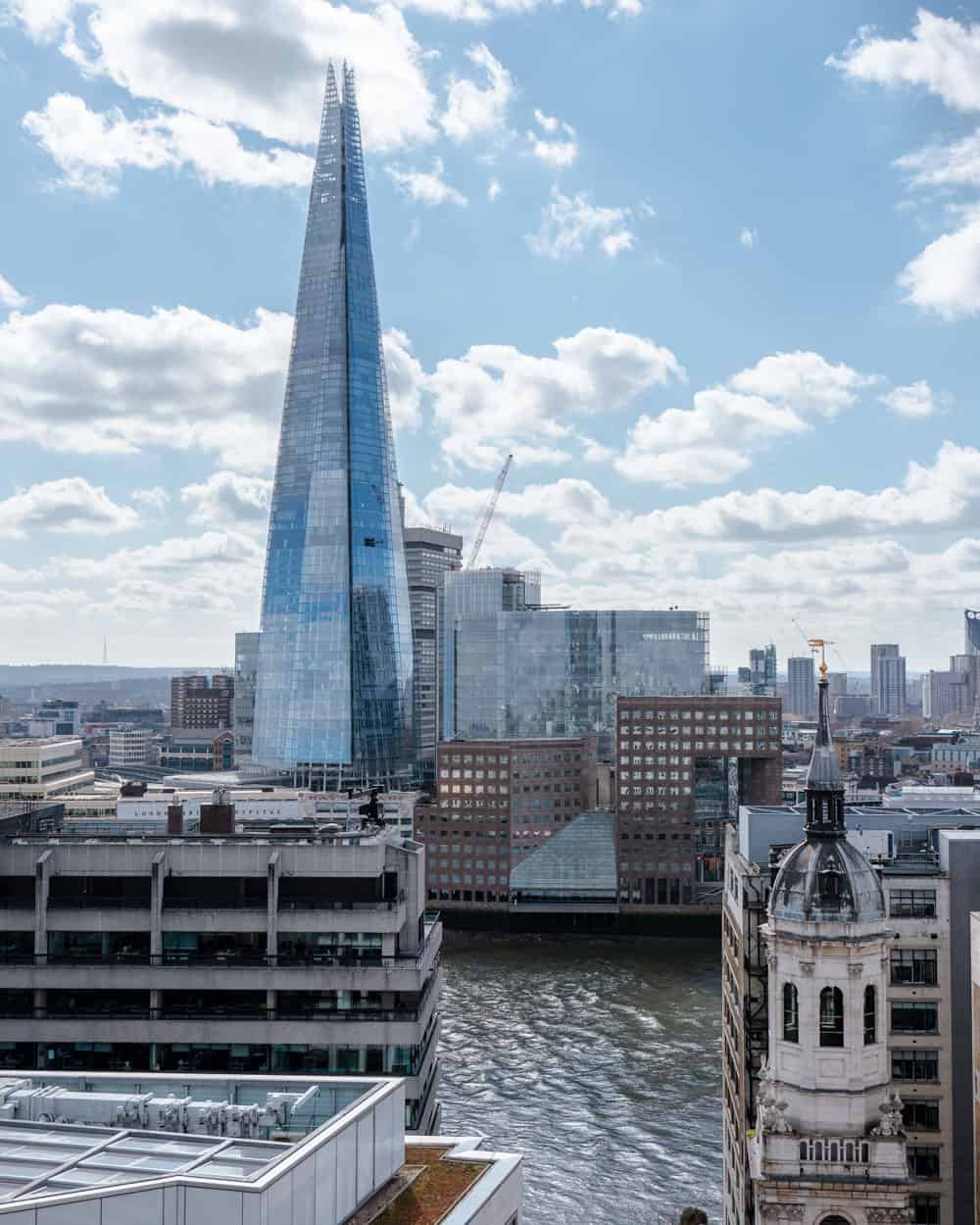
With an impressive 95 stories, The Shard is London’s tallest skyscraper and a prominent landmark on the city’s skyline. Towering at 310m (1020ft) high, it is the tallest structure in Western Europe and provides breathtaking views over London.
Since it opened in 2013, its distinctive shape, along with its height, has made it one of the most recognisable buildings in London. It also offers some of the best 360° panoramic views the city has to offer.
The vistas from The Shard on floors 68, 69 and 72 provide views at almost double the height of any other viewpoints in London.
Entrance to London’s highest view is included in the London Pass and Go City Pass. Otherwise, book your tickets online in advance, starting from £33.99.

There are also bars on some of the upper levels with ceiling-to-floor windows and spectacular views, albeit not quite as impressive as those from the top.
You can pop into one of the bars and catch a sneak peek for free. However, I’d recommend buying a cocktail or indulging in an afternoon tea (with the money you saved on the entrance ticket) and taking some time to enjoy the scene.
⛏ 29. The Gherkin (30 St Mary Axe)
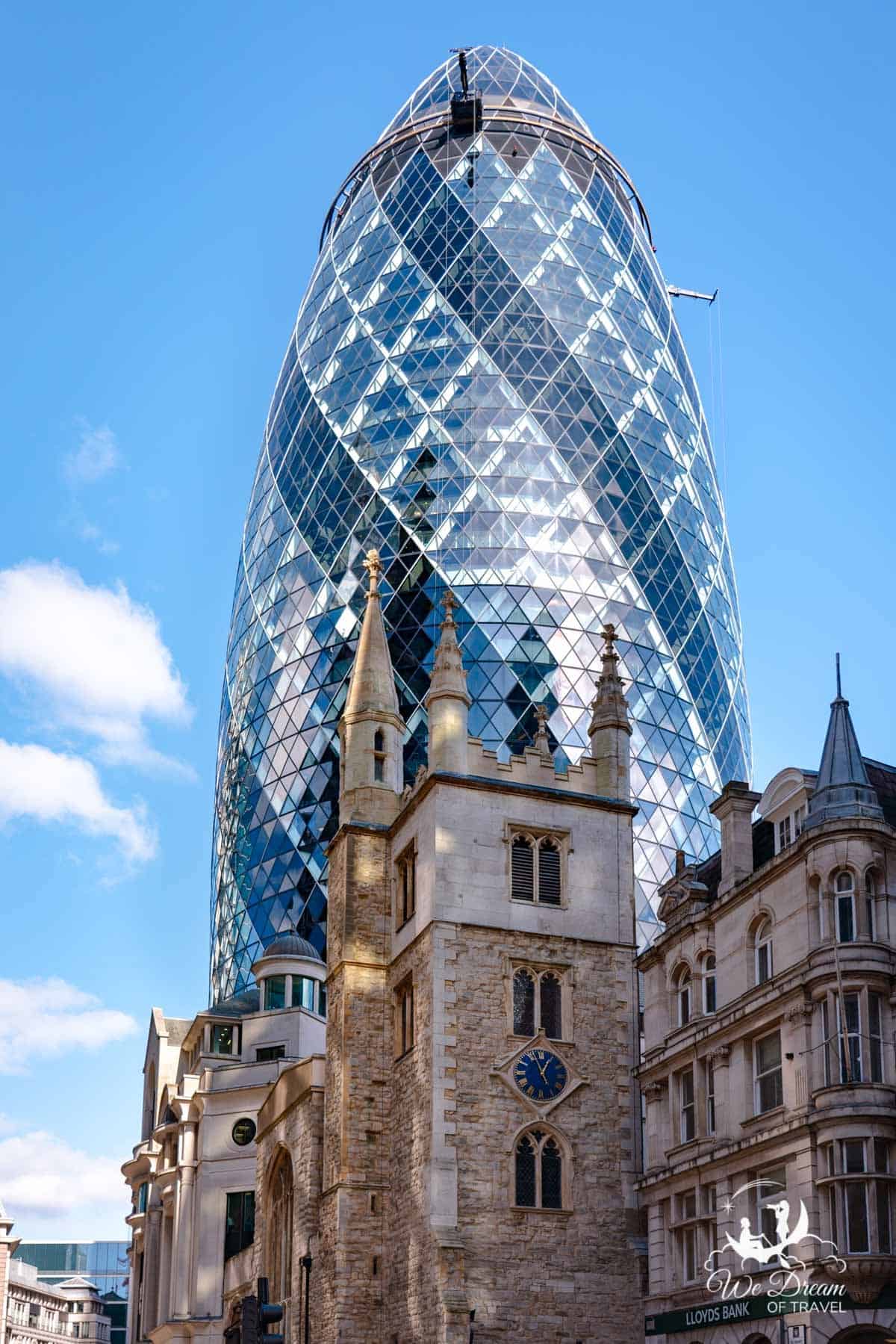
Nestled in the primary financial district, The Gherkin is one of the most famous buildings in London. Formally known as 30 St Mary Axe, it is more commonly referred to as “The Gherkin” due to its pickle-like appearance!
After two years of construction, the modern 180-metre-high skyscraper was opened in 2004. Its exterior is covered with 24,000 square metres of glass, the equivalent of five football pitches!
Despite the building’s shape, only the lens at the very top is made of curved glass.
Designed by British architect Sir Norman Foster, The Gherkin has won many architectural awards.
While most of the building contains offices and is not open to the public, the top floor is home to a restaurant and bar which provide breathtaking, uninterrupted views of the city.
📡 30. Sky Garden and the Walkie Talkie Building

Also located in the historic City of London financial district is another modern behemoth nicknamed for its distinct appearance. The Walkie Talkie Building, or 20 Fenchurch Street as it is formally known, has become a famous London landmark since its opening in 2014.
However, this notoriety wasn’t always positive! During construction in 2013, it was in the press for being responsible for melting parts of cars!
Sunlight reflecting from the glass reached temperatures of 91°c (196°F) on a nearby road. Accordingly, modifications were made to prevent this from happening in the future!

Today, the Walkie Talkie building is perhaps better known for being home to Sky Garden, one of the slightly more hidden attractions in London.
Sky Garden is the highest public garden in London and boasts stunning 360° panoramic views of the city amidst a lush urban jungle.
Set over three levels are themed, landscaped gardens. Find yourself immersed in a prehistoric forest comprised of tree ferns and fig trees, as well as flowering plants from the Mediterranean and South Africa.
Take time to explore the observation decks and open-air terrace (all of which are naturally ventilated, so expect a similar temperature to outside). There are also two restaurants and a bar where you can enjoy the view with a bite to eat or a cocktail if you prefer.
One of the great things about visiting Sky Garden is that it’s free. However, you should book a ticket in advance via the Sky Garden website.
📋 YOU MAY ALSO ENJOY:
THE ULTIMATE LONDON BUCKET LIST
🌃 31. One Canada Square, Canary Wharf
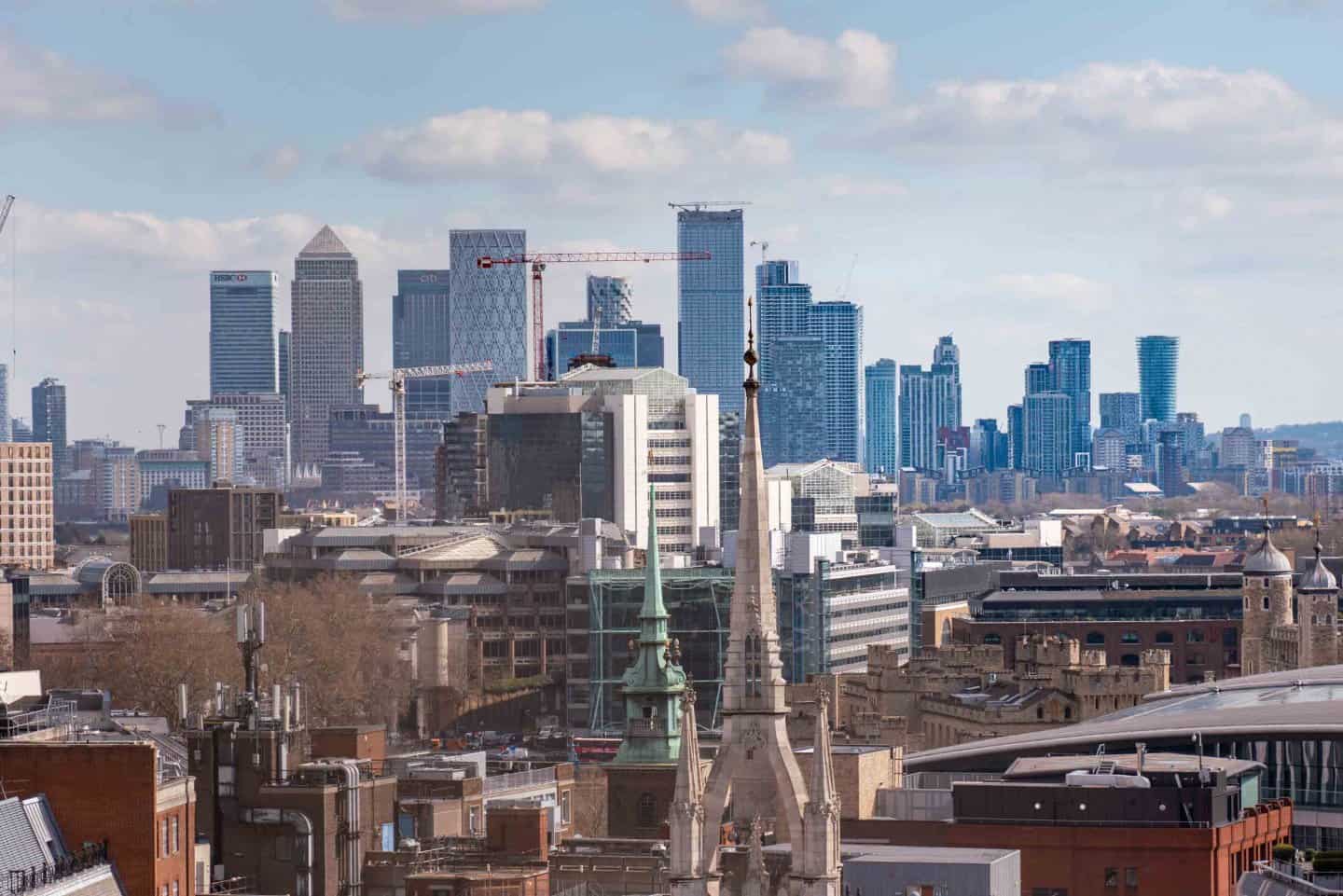
The area of Canary Wharf on the Isle of Dogs is perhaps a famous London landmark in its own right as the secondary central business district of London.
However, the most recognisable building in the area is One Canada Water, which is also the third tallest building in the UK.
With its pyramid-shaped roof reaching 235m (seen to the left in the photo above), One Canada Water can be seen from all over the city. At the top of the pyramid is a flashing light, used as an aircraft warning device.
Built in 1991, it is one of the older “modern skyscrapers”. In fact, it is often considered the second true skyscraper to have been built in London.
Today, the building continues to be primarily office space with some retail on the lower level. There are unfortunately no observation areas.
⛲️ 32. City Hall

Located in Southwark near Tower Bridge, City Hall is the headquarters for the Mayor of London and the London Assembly.
Opened in 2002, its unusual bulbous shape was designed to help the building with sustainability.
Its distinct structure minimises sun exposure, helping to optimise energy performance. By reducing its surface area, the building does not get too hot in the summer, nor lose too much heat in the winter.

I’ve always enjoyed observing this blob-like building and its juxtaposition against the more historical Tower Bridge. It reminds me of a giant woodlouse!
Side note: Its shape has been referred to “as a glass testicle” by two previous London Mayors. I haven’t been able to look at it in quite the same way again after discovering that… and now you won’t be able to either!
🌉 33. Millennium Bridge

As the name suggests, Millennium Bridge was opened in 2000 and was the first bridge to be built over the River Thames in 100 years. Since then it has quickly become an important crossing over the Thames and a London icon.
The impressive steel suspension footbridge connects the Tate Modern and Shakespeare’s Globe on the south bank of the Thames with St Paul’s on the north.
After being open only two days, Millennium Bridge was famously closed for almost 2 years and earned the nickname the “wobbly bridge”. This was due to a huge and alarming swaying motion felt by pedestrians on the bridge.
Do not fear – it has since been resolved and although you may feel a little wobble at times, it is perfectly safe! It also makes for some incredible London photo opportunities.

The bridge has gained notoriety with Harry Potter fans due to its appearance in the opening scene of Harry Potter and the Half-Blood Prince.
If you’re a Potterhead, then consider booking a Harry Potter Walking Tour to learn more about this and many other London landmarks that have appeared in the popular movies.
As you cross Millennium Bridge, look closely and you may discover one of London’s hidden gems in plain sight! Hidden pieces of art painted on chewing gum designed by the artist Ben Wilson can be seen dotted all over the bridge.
🧧 34. Chinatown Gate

Installed in 2016 after being constructed in Beijing in the Qing dynasty style, the new Chinatown Gate has quickly become a landmark in London’s West End.
The ornate gate marks the entrance to Chinatown. Here, you’ll find yourself immersed in streets decorated with Chinese symbols including dragons and lanterns, as well as Chinese street signs.
After admiring the vibrant gate, take some time to explore Chinatown. Despite being on the doorstep of Theatreland, the atmosphere of Chinatown transports you thousands of miles away.
💬 YOU MAY ALSO ENJOY:
QUOTES ABOUT LONDON TO INSPIRE YOUR NEXT TRIP
🌳 Iconic London Landmarks: Parks, Gardens & Palaces
While London has many incredible, famous buildings, it may surprise you to find out that there are over 3,000 parks covering 18% of the city.
In fact, it is considered one of the greenest cities in Europe.
These green spaces are some of London’s most famous landmarks and top attractions. I’ve also snuck a couple of palaces into this section as they also offer beautiful gardens in addition to their history.
🦌 35. Royal Parks

There are eight royal parks in London: Hyde Park, Kensington Gardens, Green Park, St James’ Park, Regent’s Park, Greenwich Park, Richmond Park and Bushy Park. With the exception of Richmond and Bushy Park, they are all located within the city centre.
The eight parks comprise a total of 5,000 acres of green spaces, all of which are free to visit and open year-round. They are the perfect place to escape the hustle and bustle of the city and enjoy a picnic or walk.
Filled with their own extensive histories, these parks are an integral part of London. Most of the parks have links back to Henry VII, many of which he acquired as hunting grounds. Although, it wasn’t until many years later that the parks were open to the public.
Of the eight royal parks, St James’ Park is the oldest. In the 13th century, a leper hospital was found here in what was once a marshy watermeadow.
It was from this hospital that the park took its name. Since 1664, St James’ Park has also been home to pelicans, which were originally a gift from a Russian Ambassador to King Charles II in 1664!

While Regent’s Park is the largest of the Royal Parks in central London, covering an area of 410 acres, it is nearly 3 times smaller than Bushy Park (1100 acres) and 6 times smaller than Richmond Park (2360 acres).
The latter two parks are the only royal parks in London to still be home to deer and are my favourites. You can find red and fallow deer roaming freely in these parks, as they have since the 1600s. Between the two parks, there are nearly 1000 deer.
🌿 36. Kew Gardens

Also known as the Royal Botanic Gardens, Kew Gardens provides a serene environment that feels like an entirely different world from the chaos of central London.
The world-famous UNESCO World Heritage Site encompasses over 300 acres and is home to 50,000 living plants in a variety of captivating ecosystems.
Within the gardens, you will also discover several iconic buildings; the Palm House, the Temperate House, and Kew Palace.
The Palm House is an enormous glasshouse that will transport you to a lush green rainforest full of tropical ferns.
Providing a very different climate, the Temperate House is home to 10,000 species of plants from the world’s temperate zones. It is also the world’s largest Victorian glasshouse.
Finally, Kew Palace is the smallest royal palace in London.
Entrance starts at £13.50 when booked online but is also covered by the London Pass and Go City Pass.
🏊🏽♀️ 37. Hampstead Heath

Hampstead Heath is one of the most famous places in London. Sprawling over an enormous 800 acres, you can spend hours meandering through woodlands and meadows on the Heath.
It is particularly famous for its breathtaking views of the London skyline and its natural swimming ponds, which make it a popular place to cool off in the summer.
🦚 38. Holland Park

Despite its smaller size, Holland Park is still an impressive London landmark. It is most famed for its Kyoto Garden which was donated to the park by the Chamber of Commerce of Kyoto in 1991 to celebrate the long friendship between Japan and Great Britain.
This outdoor London attraction is also well known for its resident peacocks.
🚣🏽♀️ 39. Regent’s Canal

Built in the early 19th century, the Regent’s Canal has long been a famous landmark in London.
The city once relied heavily on its canal system for trade. The Regent’s Canal provided a vital connection between King’s Cross to the major industrial cities in the North of England.
For over 140 years the Canal brought coal, goods and building materials to London.
Today, the Regent’s Canal and the canal district of Little Venice provides a beautiful place to explore and many photo opportunities along the way of the gorgeous narrow boats. For the best experience, take to the waters with a Venice Waterbus tour.
👑 40. Kensington Palace
Located in the Royal Borough of Kensington and Chelsea, Kensington Palace has been a royal residence for over 300 years and is a historical landmark in London.
Originally known as Nottingham Villa, King William and Queen Mary chose this place as their country retreat in 1689 and tasked Sir Christopher Wren with transforming the modest mansion into a palace.
Since this time, it has been sculpted by the many royals that have resided here. It is famously the birthplace and childhood home of Queen Victoria, before she moved to Buckingham Palace in 1837.
It has continued to be the home for royals, being the former home of Princess Diana and the current official home of the Duke and Duchess of Kent.
The palace opened certain areas to the public in 1899, which you can still visit today. Access to Kensington Palace Gardens is free to the public and is a beautiful place to stroll around, however, tickets are required to enter the palace.
Tickets to visit the King and Queen’s State Apartments cost £20 when booked online, or are included in the London Pass and Go City Pass. For an even more regal experience, you can book a Kensington Palace Gardens Tour with Royal High Tea.
41. Hampton Court Palace
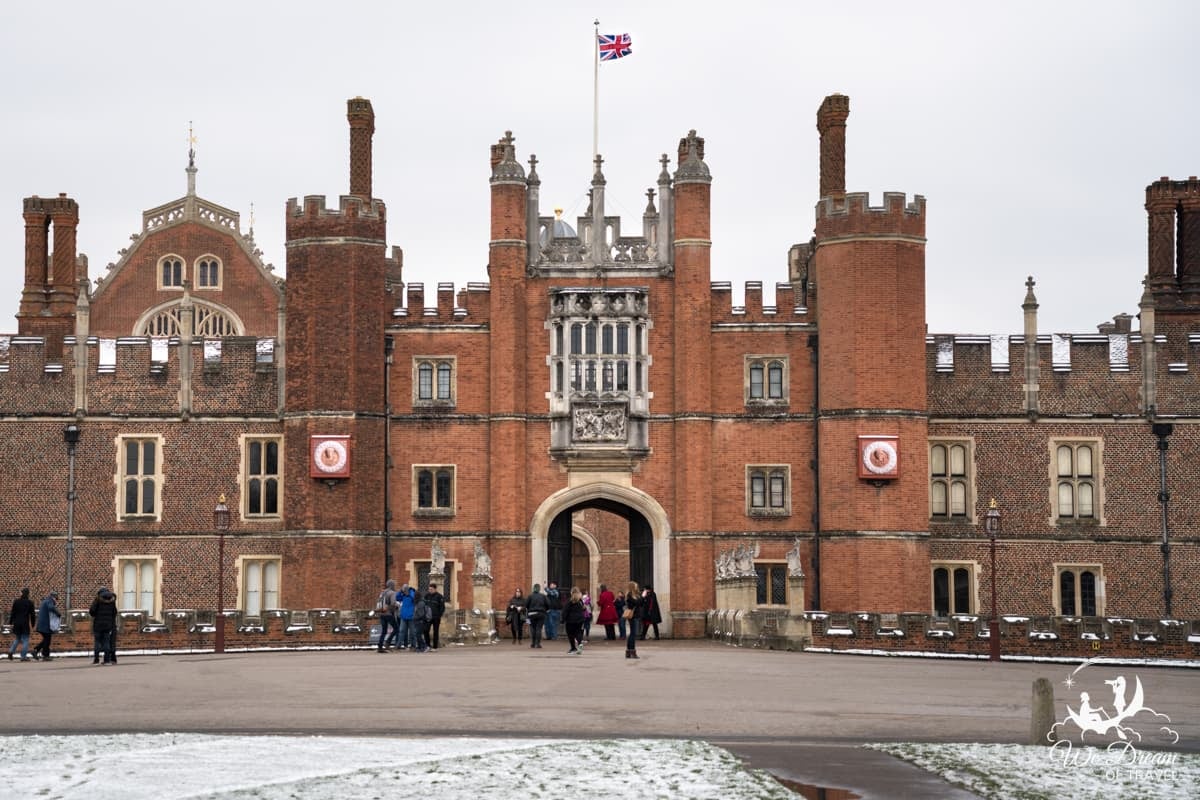
Dating back to 1523, Hampton Court Palace is a beautiful royal palace on the outskirts of London. This famous building is known for being the home to King Henry VIII and his six wives.
Over the years many changes and additions were made to the palace, including the extension of the Great Kitchen, construction of the maze, formal gardens, and canal.
Hampton Court Palace was opened to the public in 1838 and remains a top London attraction today. Here you can admire the grandeur and artwork, as well as learn more about the many nationally important events that have taken place here from historians in period costume.
Growing up near here, I have lost count of how many times I’ve visited, but this is still one of my favourite palaces to visit. They do a really great job of creating interactive experiences and often have costumed actors on site which makes it fun for both kids and adults alike.
Tickets can be purchased on the day but during peak times it is recommended to book tickets online in advance. Entry is also included within the London Pass and Go City Pass.
Additionally, there are a number of tours to Hampton Court Palace.
🏞 Other Famous Landmarks in London
I couldn’t quite fit these London landmarks into other categories, but they’re still absolutely deserving of being included. So, here they are in their own little section!
🔋 42. Battersea Power Station

During its peak in the mid-1900s, Battersea Power Station produced up to a fifth of London’s power, providing electricity to some of the most recognisable landmarks in London such as the Houses of Parliament and Buckingham Palace.
After it closed in 1983 it became an iconic cultural landmark and a Grade II* listed building but sat empty and mostly unused until 2014.
However, after undergoing massive renovations, Battersea Power Station reopened in 2021. It is now positioned to be one of the top attractions for locals and visitors alike.
The enormous complex offers a wealth of shops, bars, restaurants, leisure and entertainment venues, parks and historical spaces, and even an ice skating rink in the winter.
Additionally, 254 luxury apartments and villas have been built. So for the first time, it is possible to live in this legendary landmark (if you have a few million to spare!).
🤹🏼♀️ 43. Covent Garden

Covent Garden is one of the most famous neighbourhoods in London and my personal favourite.
Nestled in the heart of the West End this vibrant area is home to a number of stores, restaurants, and bars set across 9 streets and one historic Piazza.
At the centre of Covent Garden within the Piazza, you’ll find the covered Apple Market. It was once a produce market, but today you’ll find handcrafted, albeit touristy, crafts, as well as an array of shops and restaurants.
The area is also famous for its street entertainers. Since the 1660s, entertainers have performed in the Piazza, a custom that still continues today. You will find performances typically taking place in front of the 17th-century St. Paul’s Church, as well as scattered throughout the area.
Finally, Covent Garden is also home to the Royal Opera House and the London Transport Museum.
👩🚒 44. Monument to the Great Fire of London
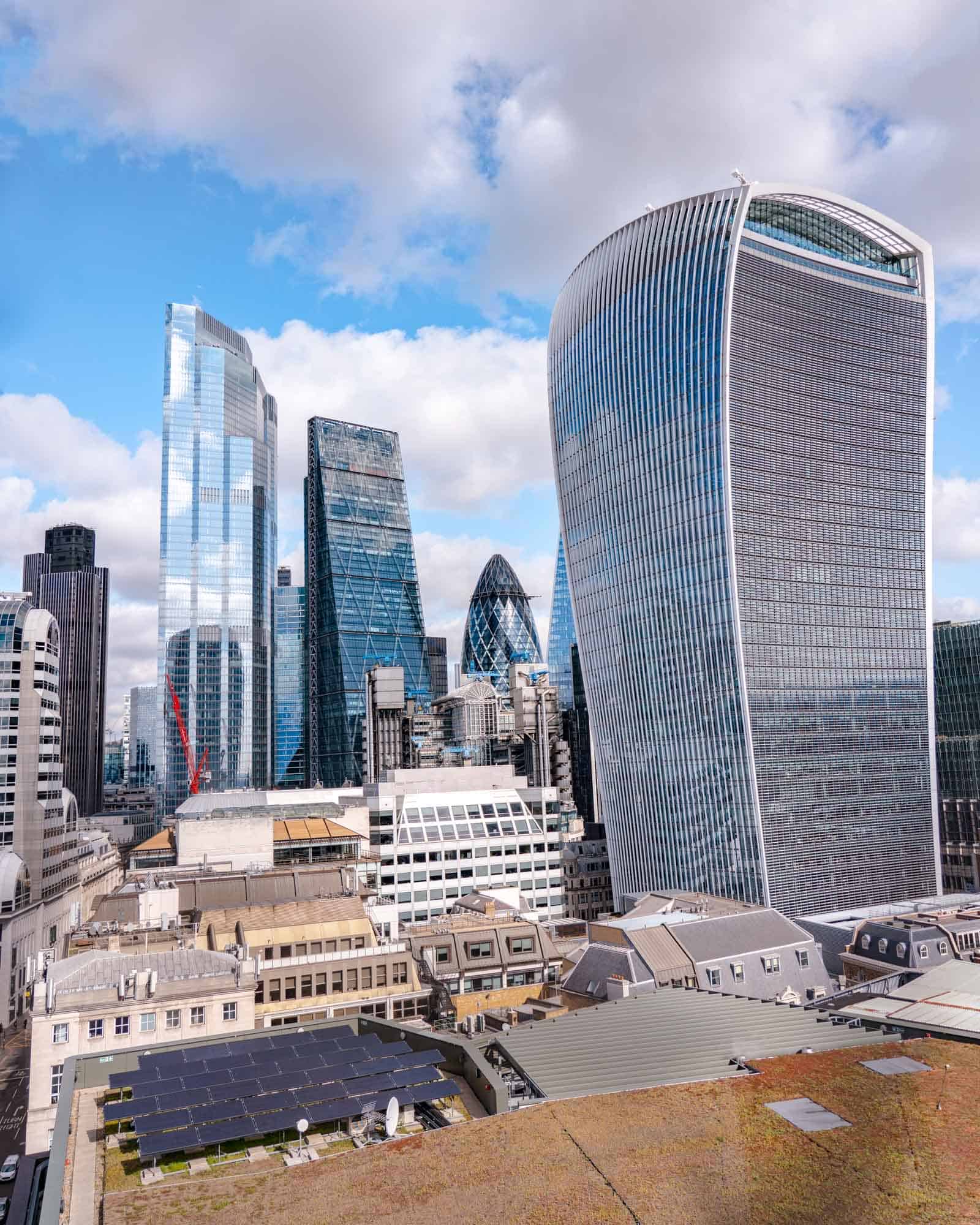
The Monument to the Great Fire of London was built between 1671 and 1677 to commemorate the Great Fire of London and to celebrate the rebuilding of the city. More commonly known simply as the Monument, it is a reminder of one of the key events that shaped London.
The monument was designed by Sir Christopher Wren and it stands at 61 metres high (202 feet); the exact distance between the monument and the site where the fire began in Pudding Lane.
Today, you can access the viewpoint at the top for some beautiful views of the city, which I only discovered a few years ago! However, you will have to climb a spiral staircase comprised of 311 stairs (although it felt like a thousand!) and pay a small entrance fee.
🚏 45. Downing Street

As the political hub of the UK, Downing Street is one of the most famous streets in London. It is the official residence of the Prime Minister at No. 10 and the Chancellor of the Exchequer at No. 11.
The famous front door of No. 10 is easily recognisable, often appearing on the news as the Prime Minister speaks of current events from his home.
The road is not accessible to the public and there are large black gates at the end of Downing Street.
To be able to enter this famous street, you must be a scheduled visitor, Parliamentary pass holder, or member of the accredited press. These restrictions have been put in place due to security risks over the years.
Fortunately for me, I have a friend who works there and was able to visit this London landmark for a photo! Although honestly, while it’s certainly a famous spot, it’s not the most exciting of the attractions in London!
🛣 YOU MAY ALSO ENJOY:
THE MOST FAMOUS LONDON STREETS
⛴ 46. HMS Belfast

The HMS Belfast is one of the most significant World War 2 Navy warships and is one of only 3 surviving bombardment vessels from D-Day. During her 33 days in Normandy, she fired over 5000 shells.
Today, the ship is one of the most famous landmarks in London. It is permanently docked just south of Tower Bridge and is open to the public as a floating museum operated by the Imperial War Museum.
Entrance to HMS Belfast is included in the London Pass and Go City Pass. Otherwise, tickets cost £24.50 when booked online.
⛵️ 47. Cutty Sark
Yet another ship on this list of famous London landmarks, the Cutty Sark was one of the fastest ships of its day. In fact, it even held the record for the fastest journey from England to Australia for 10 years.
Built on the River Clyde in Scotland, it was then transferred to London from where it took its first passage in 1870 to China. This was just the first of many grand voyages around the world.
The Cutty Sark is now a popular attraction in Greenwich where you can board the iconic clipper and learn more about its role in British history.
Entrance to Cutty Sark is included in the London Pass and Go City Pass. Otherwise, tickets can be booked online for £18. You can also buy a Royal Museums Greenwich day pass which includes entry to the Royal Observatory, Cutty Sark, National Maritime Museum, and Queen’s House.
🥙 48. Borough Market

With around 1,000 years of history, Borough Market in Southwark is the oldest food market in London and one of the most famous in the world.
While a market has existed in some form on the southern end of London Bridge since the early 11th century, the building that houses Borough Market today was constructed in the mid-1800s.
Today, you’ll find a tantalising array of global foods here. The delightful aromas instantly permeate your senses and if you’re not hungry when you arrive, your tummy will soon be rumbling!
Better still, the market is committed to sustainability and supporting small local businesses.
Borough Market reached further fame recently as the location of the Leaky Cauldron in Harry Potter and the Prisoner of Azkaban.
The market is typically open daily, except Sundays. Check the Borough Market website for current opening times.
For those that enjoy tours, consider a food tour or a Harry Potter walking tour, both of which include Borough Market as well as other iconic London sights.
👜 49. Camden Market

Nestled alongside Regent’s Canal, Camden Market is a fairly recent addition to London, dating back to 1974. It all began with a small, pop-up arts and crafts fair with only 16 stalls.
Since then, it has exploded to become the fourth most popular attraction in London.
Today, it is London’s largest market and home to over 1000 unique shops, stalls, bars, and cafes that attract 28 million visitors each year.
Meandering through the labyrinth of stalls is one of the best things to do in Camden. Here you’ll find vendors selling everything from vintage clothes to handicrafts, unique gifts, second-hand records and everything in between.
💘 READ MORE:
THE BEST THINGS TO DO IN CAMDEN TOWN
🧥 50. Portobello Road Market

Portobello Road is one of the most famous streets in London. It is renowned for being host to the world’s largest antique market each week.
Portobello Road Market originated as a regular food market, like many in London. However, over time it developed into 5 distinct areas, which still exist today;
- Secondhand goods – Golborne Road to Westway
- Clothing and fashion – Westway area
- Household items – Westway to Talbot Road
- Produce and other food – Talbot Road to Elgin Crescent
- Antiques – Elgin Crescent to Chepstow Villas
Notting Hill has been heavily gentrified since the 1980s and as such the market has also developed. Subsequently, you’ll now find cutting-edge fashion, alongside antiques and bric-a-brac.
The main day for the market is a Saturday, however, some parts of it are open other days of the week (except Sunday). Check the Portobello market website for the most up-to-date opening hours.
It is also worth noting that Portobello Road is the heart of Europe’s biggest street festival; Notting Hill Carnival. This annual event takes place at the end of August and shouldn’t be missed if you’re in London during the summer.
The entire neighbourhood is shut down while people dance in the streets in celebration of Caribbean culture.
🤪 Quirky London Landmarks
While when you think of London landmarks you may think first of all the wonderful buildings and impressive architecture scattered around the city, these quirkier London landmarks are integral parts of its character.
⛴ 51. River Thames

Running through the heart of the city and passing by many of the other famous London landmarks, the River Thames has helped to shape the capital.
While synonymous with London, what few realise is that the Thames is also England’s longest river. It spans 215 miles from its source in the Cotswolds to the coast and is home to a diverse ecosystem.

The tidal river has been intrinsically entwined with the development of London and has been a key trading route for centuries.
Today, it is still an essential route with over five million tonnes of materials being transported along the Thames each year.
It is well worth taking a cruise along the Thames to enjoy a different view of London’s most famous sights.
Jump aboard a Hop On Hop Off Thames River Cruise or the Thames Clipper to experience the city from a different vantage point.
☎️ 52. Red Phone Boxes
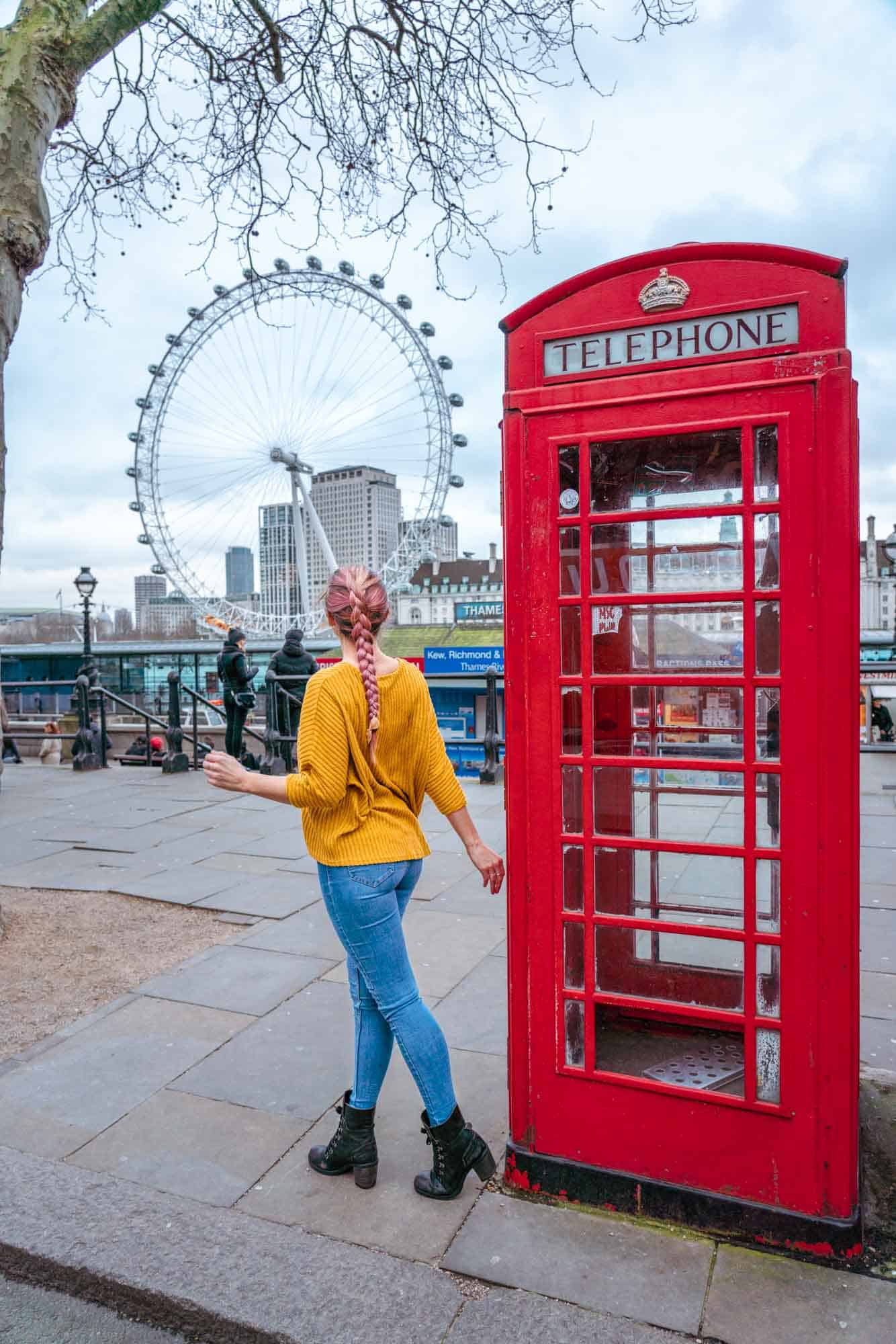
Dotted all around the city, the red telephone box is a quintessential London landmark and a famous British icon. Have you really been to London if you haven’t snapped a photo with a red phone box?!
Since 1924, these red phone boxes have graced the streets of London and the rest of Britain. Over the years there have been six different designs with small differences.
They have become so entwined with the image of London that you’ll see them adorning many different souvenirs from key rings to t-shirts in any gift shop.
Nowadays, over 5,000 traditional red telephone boxes remain in London, so you won’t have to look too far to find one.
🚍 53. Red Double Decker Buses

The red double-decker buses are as much a part of the fabric of London as the many famous buildings. Nothing lets you know you’re in London more than seeing a big red bus drive by, except maybe the rain!
Surprisingly, the double-decker buses actually originated from Paris in 1828, although at this time, they were still horse-drawn carriages. The first London bus service began in 1829, inspired by the services in Paris, and provided a route between Paddington and Bank.
It wasn’t until 1923 that the first engine-powered double-decker bus appeared in London and by 1924 there were over 200 independent buses (or pirate buses as they were known then).
Due to this, the biggest bus operator, the London General Omnibus Company, painted their buses red to stand out from the competition.
These resplendent vehicles can be spotted all over the city and, as well as adding a great splash of colour to photos, they really are a great way to get around London.
🚕 54. Black Cabs

Originally known as the Hackney Carriage, some form of London taxi has been in existence for centuries. However, they were horse-drawn until 1903 when the first motorised taxi cab hit the roads of London.
The black cab we now recognise as a symbol of London didn’t come to being until the middle of the last century. Nowadays, the boxy black cab with its orange light can be seen throughout the streets of London.
Black cabs are the only vehicles in London licensed to pick you up curbside, without a reservation. All other taxis must be booked in advance!
In order to become a black taxi driver (aka “cabby”), a London knowledge exam must first be passed which can take up to 4 years to complete.
To pass this test, they must remember 320 routes through London, 25,000 streets and 20,000 London landmarks and places of interest! Suffice to say, cabbies are extremely knowledgeable about London streets!
However, while convenient, they are also one of the most expensive ways to travel in London.
If you do want to experience London in one of its most iconic vehicles, you can even book a private black cab London tour.
🚇 55. The Tube

The London Underground, or Tube as it is more commonly known, dates back to 1863 when the world’s first underground passenger railway, the Metropolitan Railway, opened.
Since then it has expanded to include 11 lines which collectively transport 5 million passengers per day. The development of the tube has also shaped the city, providing mobility in a way that would not have otherwise been possible.
Today, both the underground map and the logo have become an iconic part of London’s identity.
🤔 Final Thoughts
The two of us work very hard to create these free travel guides to help you plan your dream vacation. If you think we’ve done a good job and would like to say thanks, please consider clicking the donate button below 🙂
London is truly a treasure trove when it comes to landmarks. With an extensive history dating back millennia, it’s no surprise that there are so many beautiful buildings with interesting histories to discover.
Add to that some modern architectural marvels, renowned transport, stunning green spaces, and world-class attractions, and you’ll just scratch the surface of what makes London such a special city.
I hope you’ve enjoyed this guide to the most iconic London landmarks. As always, we love to hear your feedback so leave us a comment below and let me know what you think. Do you have a favourite landmark? Or have I missed one from this list?
And finally, before you go, you may enjoy some of our other London guides:
- The PERFECT London Itinerary
- Most Famous Streets in London
- Ultimate London Bucket List
- Non Touristy Things to Do in London
- Most Instagrammable Places in London
- Notting Hill Colorful Houses
- Best Things to Do in Camden
- Best Castles near London
- Quotes About London to Inspire You
If you’re fortunate enough to have a bit longer in England, I’d recommend visiting some of the prettiest villages in the Cotswolds or taking a day trip to the White Cliffs of Dover from London.
📌 Enjoyed this guide to Famous Landmarks in London? Pin it! 🙂
Because sharing is caring…







I loved this post! We visited London a few years ago and this brought back so many wonderful memories. You totally do look like a princess in front of the palace. How fun!
Thanks Ashlee. I’m so happy to hear you had a good time in London. Most of my life is spent in leggings and hoodies… but every now and then it’s fun to pretend to be a princess!! 🙂
You definitely covered all the best spots in London. One of my favorite cities. At first I was wondering how you got that close to Number 10, I was almost positive you can’t just stroll up to it. Despite being a bit of an underwhelming place usually, that’s pretty cool you got a pic there
Thanks so much Emma! Haha yeah you definitely can’t just rock up to no. 10 any more. It was pretty cool to be able to walk past all the tourists and head straight to the door!
I’ve been to most of these but still haven’t visited the British Museum! Thanks for reminding me – next trip for sure!
There’s always something more to discover in London that’s for sure. The British Museum is the one I need to get back to the most too, it’s been years since I’ve visited it.
You make me miss London so much! It was literally my jumping off point before the pandemic. Will be back soon!
Aww I hope you can make it back soon… luckily London isn’t going anywhere!! 🙂
I live just outside of London, but haven’t been in for ages because of the travel restrictions. Really looking forward to heading back in and taking the kids on a tour of all these iconic landmarks. So exciting!
I hope you and the kids get back up there again soon. I’ve been a few times as restrictions have eased, but really miss being able to visit the museums and other indoor venues, it’s just not quite the same otherwise!
Wow! This article beautifully captures the essence of London’s iconic landmarks, igniting my wanderlust instantly. As a travel enthusiast, I’m thrilled to explore these famous sites and immerse myself in the rich history and culture of this vibrant city. Can’t wait to tick off each landmark from my bucket list!
Thank you so much Kai. I’m glad to hear you found this list of London landmarks useful. I hope you have a wonderful time exploring London 🙂
– Sophie